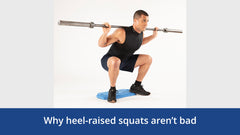Heel-raised squats aren’t bad


BY NICK TUMMINELLO, AUTHOR OF STRENGTH ZONE TRAINING
AUGUST 2022
Lifters usually elevate their heels during barbell back squats for three reasons:
- To increase their squat depth
- Because it feels better to them
- To keep their torso more upright, which increases demand on the quads
- It reinforces dysfunctional movement, which could increase your injury risk.
- It teaches your body how to squat wrong. Why not teach your body how to squat with your feet flat?
Are they right? No matter how good an exercise is, some trainers will claim it’s bad for the two reasons listed. And although we’re looking specifically at the heelraised squat, the same points you’ll see here can refute arguments against other “bad” exercises. So let’s cut through the confusion, and then you can decide whether elevating your heels during squats is a thing you’d benefit from doing.
They Don’t Reinforce Dysfunctional Movement
The reason some trainers say they reinforce dysfunctional movement is because squatting with your heels elevated eliminates ankle dorsiflexion (when you bend at the ankle). Whereas, squatting with your feet flat forces your ankles into dorsiflexion. This is why people with restricted ankle dorsiflexion feel like they can keep their knees and torso in better alignment when using a heel lift.
So in the case of someone with limited range of motion during ankle dorsiflexion, heel-raised squats do not increase their limitation but instead offer a technique that allows them to squat in a way that is more comfortable while working around their limitation. I agree with the concern about ignoring restricted range of motion during ankle dorsiflexion. It’s been associated with issues such as ankle injuries and knee injuries, and it may also lead to abnormal lower extremity biomechanics during multi-joint strengthening exercises.
It’s important to work on improving ankle dorsiflexion if it’s limited and to work on maintaining your current range of motion if it is not restricted. However, this in no way means heel-raised squats are a bad exercise that people must avoid, regardless of their available ankle dorsiflexion range of motion. It just means that they need to do other exercises that involve moving or loading their ankle complex in the ranges not accessed during heel-raised squats, such as the calf exercises.
In other words, it’s not that heel-raised squats will cause you to lose your range of motion during ankle dorsiflexion. It’s that you’ll lose it if you don’t do anything regularly that involves ankle dorsiflexion. This is why we do multiple exercises for all areas of the body in the strength zone training system: one exercise allows you to train in ranges of motion missed by another exercise. That said, go ahead and do heel-raised squats as you see fit. Just make sure you also do the calf exercises, which are designed to increase your range of motion and build strength.
They Don’t Make You Less Capable of Squatting Without a Lift
Some lifters who can do squats without the heel raised use an elevated heel to squat because it hits their quads more. Some do it because it involves less of the lower back, allowing them to go deep and still maintain a more upright torso.
But critics will argue against these reasons stating that the heel raise teaches your body to squat this way and, as a result, you’ll lose your ability to squat well with heels on the ground. There are several problems with this line of thinking. Using their logic, I could say that trainers should never have clients or athletes ride a bike because it teaches them to move forward this way, therefore making them less able to walk or run properly. Each step you’d take would be in an (attempted) circular fashion if this were the case. We all know that just because the body learns how to ride a bike, that in no way causes the body to forget how to walk or run the way it normally does.
Learning how to do new things doesn’t detract from other skills you’ve acquired because the human body is highly adaptable. It can learn lots of ways to move without one thing interfering with another. Multisport athletes are a shining example of this. In fact, they’re more functional—not less—when they’ve exposed their bodies to many different forms of movement.
That said, it’s a different story if all you ever do is squat with your heels raised. Then, yes, you’ll get used to squatting that way. The best approach is to expose yourself to different squat variations to make your body more adaptable. That way, mixing in heel-raised squats won’t reduce your ability to squat well when your feet are flat.
Learn more:
Learn more in Strength Zone Training. Renowned personal trainer Nick Tumminello, who has become known as the trainer of trainers, shows you the following:
- How to build strength through the true full range of motion
- The redundant exercises you just don’t need to do
- The exercises to maximize upper body and lower body strength that are missing from your workout
- The angles most people don’t do exercises for but should
- The best exercises to include in your program to train each muscle group
- A better strategy to follow when choosing your exercises
- Beginner and advanced workout plans for any schedule

Latest Posts
- A Guide for Fitness Professionals: Dr. Barbara A. Bushman on Fitness Professional’s Handbook, Eighth Edition
- Single-leg vs. double-leg training for athleticism
- Fountain of youth for athleticism: Lifting, sprinting, or jumping?
- Cause-and-effect connection between physical activity and specific outcomes
- The science of getting stronger without weights
- BODYBUILDING ANATOMY


